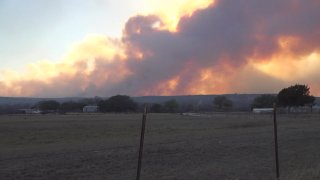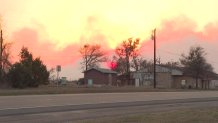
Crittenburg Complex Fire, March 2022.
State and local firefighters are currently working on 12 active wildfires in Texas Monday afternoon as the potential for more wildfires this week may outpace suppression efforts.
As of 1 p.m. Monday, The Texas Wildfire Incident Response System shows a dozen active fires in the state spreading from the Texarkana area into the Rio Grande Valley.
Watch NBC 5 free wherever you are
The largest active fire is the Eastland Complex fire which began burning more than a week ago. Since that time the fire, which is 90% contained, has consumed more than 54,000 acres.
Get top local stories in DFW delivered to you every morning with NBC DFW's News Headlines newsletter.
The Crittenburg Complex fire near Fort Hood is the next largest fire on the list. The fire has currently burned more than 33,000 acres in Coryell County and is 45% contained as of 3 p.m. Monday.
"State, local and federal firefighters have been extremely busy responding to increased wildfire activity," says Rich Gray, Texas A&M Forest Service Chief Regional Fire Coordinator. "Fire resources are mobilized to areas of concern for a quick and effective response to any requests for assistance."
The National Weather Service said smoke from the Crittenburg Complex fire was pushing north into DFW. MedStar EMS said the smoke could cause problems for those with existing breathing issues.
The forest service warns that nine out of 10 wildfires in Texas are human-caused and they encourage the public to avoid outdoor activities that cause a spark while warm, dry, and windy conditions are present.
If a wildfire is spotted, immediately contact local authorities.
To see a map showing all active wildfires in the state, click here.

FIRE DANGER THIS WEEK
Texas News
News from around the state of Texas.
The Texas A&M Forest Service said Monday critically to extremely dry vegetation mixed with well-above normal temperatures and increased wind speed will make the potential for large wildfires greater this week west of the Interstate 35 corridor.
The forest service said many of the wildfires recently battled in the state exhibited extreme fire behavior "including group torching, or the transition of fire from the ground to the canopy of trees, and spotting of embers and flammable material ahead of the active wildfire."
"As conditions across a large portion of the state worsen, wildfires that ignite are burning more intensely and are frequently resistant to control," said Wes Moorehead, Texas A&M Forest Service Fire Chief. "Unfortunately, little to no precipitation is forecast for the immediate future and we expect the current level of wildfire activity to continue for some time."
The forest service said so far in the month of March state and local resources have responded to 726 wildfires that burned 164,257 acres across the state. Over the past 7 days, fire resources responded to 121 wildfires that burned 35,728 acres.
SUPPRESSION EFFORTS (FROM TAMU FOREST SERVICE)
In a statement Monday, the forest service said they have staged fully-staffed task forces and additional suppression equipment in Alice, Amarillo, Beeville, Brownwood, Burkburnett, Childress, Edinburg, Fort Stockton, Fredericksburg, Lubbock, McGregor, Merkel, Mineral Wells, Pleasanton, San Angelo, Smithville, and Victoria.
Resources from 34 states have been mobilized to Texas this month to support wildfire response efforts.
Aircraft were heavily utilized over the past week to support suppression efforts on the ground, responding to multiple wildfires and dropping a total of 263,000 gallons of water and retardant to slow the forward progression of the fires.
Thirty-five aviation resources are currently staged in the state, including three large air tankers, 15 single-engine air tankers, five air attack platforms, two aerial supervision modules, three Type 1 helicopters, two Type 3 helicopters, four Blackhawks, and one multi-mission aircraft. Texas A&M Forest Service does not own any aviation resources but instead uses federal aviation contracts through the U.S. Forest Service and Bureau of Land Management for all firefighting aircraft.
Texas A&M Forest Service and the Texas Division of Emergency Management also worked together to mobilize twelve strike teams via Texas Intrastate Fire Mutual Aid System (TIFMAS) to provide wildfire incident support.
For current conditions and wildfire outlook, read the Texas Fire Potential Outlook.



